 W
WParachuting is a method of transiting from a high point to Earth with the aid of gravity, involving the control of speed during the descent using a parachute or parachutes. It may involve more or less free-falling which is a period when the parachute has not yet been deployed and the body gradually accelerates to terminal velocity.
 W
WThe 3-ring release system is a parachute component that is widely used by sport skydivers and military freefall parachutists to attach the two risers of a main parachute to the harness that bears the load under the parachute.
 W
WAccelerated freefall (AFF) is a method of skydiving training. This method of skydiving training is called "accelerated" because the progression is the fastest way to experience solo freefall, normally from 10,000 to 15,000 feet above ground level (AGL). In static line progression, more jumps are required to experience freefall, but the jumps are less expensive for the student as one instructor can dispatch multiple students per load and students are initially dispatched from lower altitudes. Under accelerated freefall, one or sometimes two instructors are dedicated just to one student.
 W
WAccuracy landing is one of the oldest skydiving disciplines, in which skydivers attempt to land as closely as possible to a pre-determined target.
 W
WAn airdrop is a type of airlift, developed during World War II to resupply otherwise inaccessible troops, who themselves may have been airborne forces. In some cases, it is used to refer to the airborne assault itself.
 W
WIn skydiving, an automatic activation device (AAD) is an electronic-pyrotechnic or mechanical device that automatically opens the main or reserve parachute container at a preset altitude or after a preset time.
 W
WThomas Scott Baldwin was a pioneer balloonist and U.S. Army major during World War I. He was the first American to descend from a balloon by parachute.
 W
WA ballistic parachute, ballistic reserve parachute, or emergency ballistic reserve parachute, is a parachute ejected from its casing by a small explosion, much like that used in an ejection seat. The advantage of the ballistic parachute over a conventional parachute is that it ejects the parachute canopy, causing it to open rapidly, this makes it ideal for attaching to light aircraft, hang gliders and microlights, where an emergency situation may occur in close proximity to the ground. In such a situation, a conventional parachute would not open quickly enough.
 W
WBanzai skydiving is a rumored form of skydiving in which the skydiver throws their parachute out the airplane door, waits, and then jumps after it. To be successful, the skydiver must catch the parachute, secure it, and glide to the projected landing zone. There is no known, credible evidence that a banzai skydive has ever really occurred according to its definition.
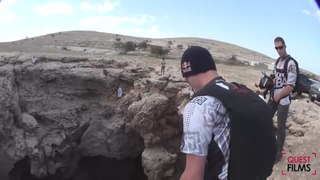 W
WBASE jumping is the recreational sport of jumping from fixed objects, using a parachute to descend safely to the ground. "BASE" is an acronym that stands for four categories of fixed objects from which one can jump: building, antenna, span, and earth (cliff). Participants exit from a fixed object such as a cliff, and after an optional freefall delay, deploy a parachute to slow their descent and land. A popular form of BASE jumping is wingsuit BASE jumping.
 W
WA canopy formation is a formation built by parachutists by flying their parachutes in proximity to each other and then taking grips ("docking") on other jumpers' parachutes.
 W
WCanopy piloting encompasses several disciplines, all involving the flight of a skydiving parachute.
 W
WThe Cirrus Airframe Parachute System (CAPS) is a whole-plane ballistic parachute recovery system designed specifically for Cirrus Aircraft's line of general aviation light aircraft including the SR20, SR22 and SF50. The design became the first of its kind to become certified with the FAA, achieving certification in October 1998, and remains the only aircraft ballistic parachute used as standard equipment by an aviation company.
 W
WCutaway is a 2000 American made-for-television action film about skydiving, directed by Guy Manos. The term "cut-away" is used frequently in the film, in reference to parachuting and also in reference to life in general. Cutaway stars Tom Berenger, Stephen Baldwin, Dennis Rodman, Maxine Bahns, Ron Silver, Casper Van Dien and Thomas Ian Nicholas. This was Dennis Rodman's third film.
 W
WCYPRES is an acronym for Cybernetic Parachute Release System. It refers to a specific make and model of an automatic activation device (AAD), a device that automatically activates a parachute under certain circumstances. A CYPRES is designed to activate the reserve parachute at a preset altitude if the rate of descent is over a certain threshold. The manufacturer of the CYPRES is Airtec.
 W
WA drogue parachute is a parachute designed for deployment from a rapidly-moving object. It can be used for various purposes, such as to decrease speed, to provide control and stability, or as a pilot parachute to deploy a larger parachute. Vehicles that have used drogue parachutes include multi-stage parachutes, aircraft, and spacecraft recovery systems.
 W
W W
WFormation skydiving is a skydiving event where multiple skydivers attach themselves to one another by grabbing each other's limbs or by the use of "grippers" on their jumpsuit while free falling through the sky. The goal of this skydiving program is to build a formation of multiple divers arranged in a geometric pattern.
 W
WFreeflying is a skydiving discipline which began in the late 1980s, involving freefalling in various vertical orientations, as opposed to the traditional "belly-to-earth" orientation. The discipline is known to have originated when Olav Zipser began experimenting with non-traditional forms of bodyflight. Zipser founded the FreeFly Clowns as a two-person competitive team with Mike Vail in 1992, and was joined by Omar Alhegelan, Charles Bryan, and Stefania Martinengo in 1994. The FreeFly Clowns are also credited with opening the first school to teach freeflying, The First School of Modern SkyFlying.
 W
WJojo Wings is a Czech aircraft manufacturer based in Roudnice nad Labem. The company specializes in the design and manufacture of paragliders and parachutes in the form of ready-to-fly aircraft. The company also makes parafoil kites.
 W
WKluz PS-11 is sport parachute of the Rogallo wing type. Its weight is 10 kilograms (22 lb) and its span is 6.16 metres (20.2 ft). It was originally produced in the Franjo Kluz factory in Inđija, but production was moved to Belgrade in 1951.
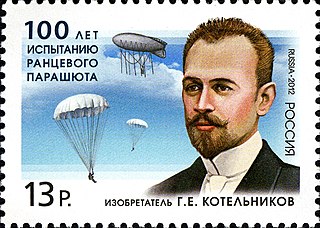 W
WGleb Yevgeniyevich Kotelnikov, was the Russian-Soviet inventor of the knapsack parachute, and braking parachute.
 W
WLouis-Sébastien Lenormand was a French chemist, physicist, inventor, and a pioneer in parachuting.
 W
WThe low-altitude parachute-extraction system (LAPES) is a tactical military airlift delivery method where a fixed-wing cargo aircraft can deposit supplies in situations in which landing is not an option, in an area that is too small to accurately parachute supplies from a high altitude.
 W
WA malfunction is a partial or total failure of a parachuting device to operate as intended. Malfunctions may require a skydiver to cut away his or her main parachute and deploy the reserve parachute.
 W
WRichard Floyd McCoy Jr. was an American aircraft hijacker. McCoy hijacked a United Airlines passenger jet for ransom in 1972. Due to a similar modus operandi, law enforcement officials named McCoy as a suspect for the still-unidentified "D. B. Cooper", who committed his unsolved crime four-and-a-half months before McCoy.
 W
WParaavis Company is a Russian aircraft manufacturer based in Moscow and founded in 1992. The company specializes in the design and manufacture of paramotors, paragliders, parachutes, powered parachutes and parafoil kites for kitesurfing, in the form of ready-to-fly aircraft for the US FAR 103 Ultralight Vehicles rules and the European Fédération Aéronautique Internationale microlight category.
 W
WA parachute is a device used to slow the motion of an object through an atmosphere by creating drag. Parachutes are usually made out of light, strong fabric, originally silk, now most commonly nylon. They are typically dome-shaped, but vary, with rectangles, inverted domes, and others found. A variety of loads are attached to parachutes, including people, food, equipment, space capsules, and bombs.
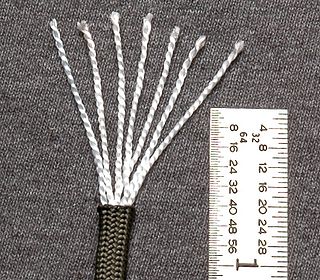 W
WParachute cord is a lightweight nylon kernmantle rope originally used in the suspension lines of parachutes. This cord is now used as a general purpose utility cord. This versatile cord was used by astronauts during the 82nd Space Shuttle mission to repair the Hubble Space Telescope.
 W
WA parachute landing fall (PLF) is a safety technique that allows a parachutist to land safely and without injury. The technique is performed by paratroopers and recreational parachutists alike. The technique is used to displace the energy of the body contacting the earth at high speeds. The parachutist ideally lands facing the direction of travel with feet and knees together. At the moment first contact is made with the ground, the person goes from an upright position to absorbing the impact by allowing the body to buckle and go toward a horizontal position while rotating toward the side. When executed properly, this technique is capable of allowing a parachutist to survive uninjured during landing speeds that would otherwise cause severe injury or even death.
 W
WA parafoil is a nonrigid (textile) airfoil with an aerodynamic cell structure which is inflated by the wind. Ram-air inflation forces the parafoil into a classic wing cross-section. Parafoils are most commonly constructed out of ripstop nylon.
 W
WParasailing, also known as parascending or parakiting, is a recreational kiting activity where a person is towed behind a vehicle while attached to a specially designed canopy wing that resembles a parachute, known as a parasail wing. The manned kite's moving anchor may be a car, truck, or boat. The harness attaches the pilot to the parasail, which is connected to the boat, or land vehicle, by the tow rope. The vehicle then drives off, carrying the parascender and person into the air. If the boat is powerful enough, two or three people can parasail behind it at the same time. The parascender has little or no control over the parachute. The activity is primarily a fun ride, not to be confused with the sport of paragliding.
 W
WKatharina “Käthe” Paulus was a German exhibition parachute jumper and the inventor of the first collapsable parachute. At the time, the parachute was named, 'rescue apparatus for aeronauts' in 1910. The previous parachutes were not able to fit in a case like apparatus worn on the back, thus Paulus' invention became of paramount importance for the Germans in World War I and she produced about 7000 parachutes for the German forces. During World War I Paulus created approximately 125 parachutes a week. Paulus was also credited with inventing the drag 'chute, an intentional breakaway system where one small parachute opens to pull out the main parachute.
 W
WA pilot chute is a small auxiliary parachute used to deploy the main or reserve parachute. The pilot chute is connected to the deployment bag containing the parachute by a bridle. Pilot chutes are a critical component of all modern skydiving and BASE jumping gear. Pilot chutes are also used as a component of spacecraft such as NASA's Orion.
 W
WPowered paragliding, also known as paramotoring or PPG, is a form of ultralight aviation where the pilot wears a back-mounted motor which provides enough thrust to take off using a paraglider. It can be launched in still air, and on level ground, by the pilot alone — no assistance is required.
 W
WA reserve static line, occasionally called a Stevens Lanyard, is a device that automatically opens the reserve parachute container when the main parachute is cut-away. The RSL is a lanyard connecting one or both of the main parachute risers to the reserve ripcord.
 W
WA parachute is a device used to slow the motion of an object through an atmosphere by creating drag. Parachutes are usually made out of light, strong fabric, originally silk, now most commonly nylon. They are typically dome-shaped, but vary, with rectangles, inverted domes, and others found. A variety of loads are attached to parachutes, including people, food, equipment, space capsules, and bombs.
 W
WSki-BASE jumping is the recreational sport of skiing at a high speed off of a cliff or mountain and free-falling through the air, using a parachute to descend to the ground, therefore combining the two sports of skiing and BASE jumping. Participants often perform tricks or manoeuvres during the freefall and remove their skis mid-air in order to safely deploy the parachute and land.
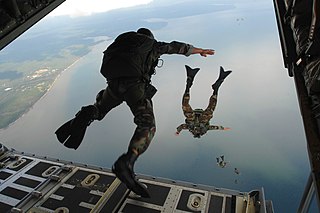 W
WSkydiver day is an unofficial holiday of skydivers, annually celebrated on 26 July in some countries, such as Ukraine, Kazakhstan, Belarus, and Russia. In Brazil, skydiver day is celebrated on 22 October.
 W
WThe Skydivers is a 1963 film produced by Anthony Cardoza and written and directed by Coleman Francis, who together also made The Beast of Yucca Flats. It stars actress Kevin Casey as Beth, along with, also from The Beast of Yucca Flats, Eric Tomlin as Joe, Anthony Cardoza as Harry, and Marcia Knight as Suzy. The film contains performances by influential Nashville guitarist Jimmy Bryant.
 W
WSky surfing is a type of skydiving and extreme sport in which the skydiver wears a custom skysurf board attached to his or her feet and performs surfing-style aerobatics during freefall.
 W
WA slider is a small rectangular piece of fabric with a grommet near each corner used to control the deployment of a "ram-air" parachute. Also called a "reefing device." A ram-air parachute has a tendency to open very rapidly. At high velocities, the opening shock from a rapid deployment can cause damage to the canopy or injury to the jumper. The slider was developed as a way of mitigating this. During deployment, the slider slides down from the canopy to the risers. Air resistance slows its descent. The slider holds the lines together, which slows the parachute inflation. The slider also deflects some of the rising air column away from the center of the canopy as it inflates. This also helps moderate the speed of opening. This invention solved the rapid deployment problem with ram-air designs. Sliders also reduce the chance of the lines twisting to cause a malfunction.
 W
WHilder Florentina Youngberg Smith was an aerial acrobat, parachutist, and pioneer aviator. She was one of California's first female pilots and the first woman to fly an airplane from LAX. Hilder was a member of a flying aerial team called The Flying Sylvesters.
 W
WJames Floyd Smith was an inventor, aviation pioneer, and parachute manufacturer. With borrowed money, he built, then taught himself to fly his own airplane. He worked as a flight instructor and test pilot for Glenn L. Martin at Bennett's bean field, which became LAX. From San Diego in 1916, Smith won the Aero Club of America's Medal of Merit by setting three altitude records, flying a Martin S seaplane reaching that aircraft's ceiling of 12,333 feet. During World War I, he formed the Floyd Smith Aerial Equipment Company in San Diego, California. In May 1920, he won a patent for the first back pack, free fall type, ripcord operated parachute. Smith's original ripcord parachute is on display at the National Museum of the United States Air Force at Dayton, Ohio.
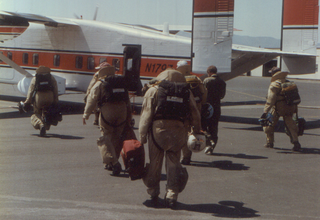 W
WSmokejumpers are specially trained wildland firefighters who provide an initial attack response on remote wildland fires. They are inserted at the site of the fire by parachute.
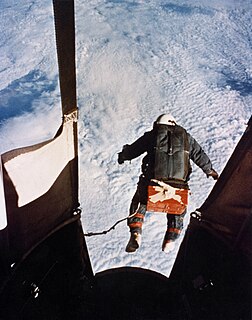 W
WSimilar to skydiving, space diving is the act of jumping from an aircraft or spacecraft in near space and falling towards Earth. The Kármán line is the internationally accepted definition as to where space begins, 100 km (62 mi) above sea level. This definition is accepted by the Fédération Aéronautique Internationale (FAI), which is an international standard setting and record-keeping body for aeronautics and astronautics. The United States Air Force uses 50 mi (80 km) to award astronaut wings.
 W
WThe Space Games is a freefly skydiving competition event created by 'Father of ' FreeFly' Olav Zipser.
 W
WA static line is a fixed cord attached to a large, stable object. It is used to open parachutes automatically for paratroopers and novice parachutists.
 W
WAlbert Leo Stevens was a pioneering balloonist.
 W
WTandem skydiving or tandem parachuting refers to a type of skydiving where a student skydiver is connected to an instructor via a harness. The instructor guides the student through the whole jump from exit through freefall, piloting the canopy, and landing. The student needs only minimal instruction before making a tandem jump with the instructor. In the United States most skydiving centers and clubs require that you be 18 years or older to skydive whereas in other countries the minimum age can be lower or higher. This is one of three commonly used training methods for beginning skydivers; the others being Static line, Instructor-assisted deployment (IAD), and Accelerated freefall (AFF) (k).
 W
WA vertical wind tunnel (VWT) is a wind tunnel which moves air up in a vertical column. Unlike standard wind tunnels which have test sections that are oriented horizontally, as experienced in level flight, a vertical orientation enables gravity to be countered by drag instead of lift, as experienced in an aircraft spin or by a skydiver at terminal velocity.
 W
WWingsuit flying is the sport of flying through the air using a wingsuit which adds surface area to the human body to enable a significant increase in lift. The modern wingsuit, first developed in the late 1990s, creates a surface area with fabric between the legs and under the arms. Wingsuits are sometimes referred to as "birdman suits", "squirrel suits", and "bat suits".
 W
WOlav Zipser is a highly accomplished, multiple-time world champion, trainer of multiple world champions, Sports Emmy Award-winning, pioneering skydiver.